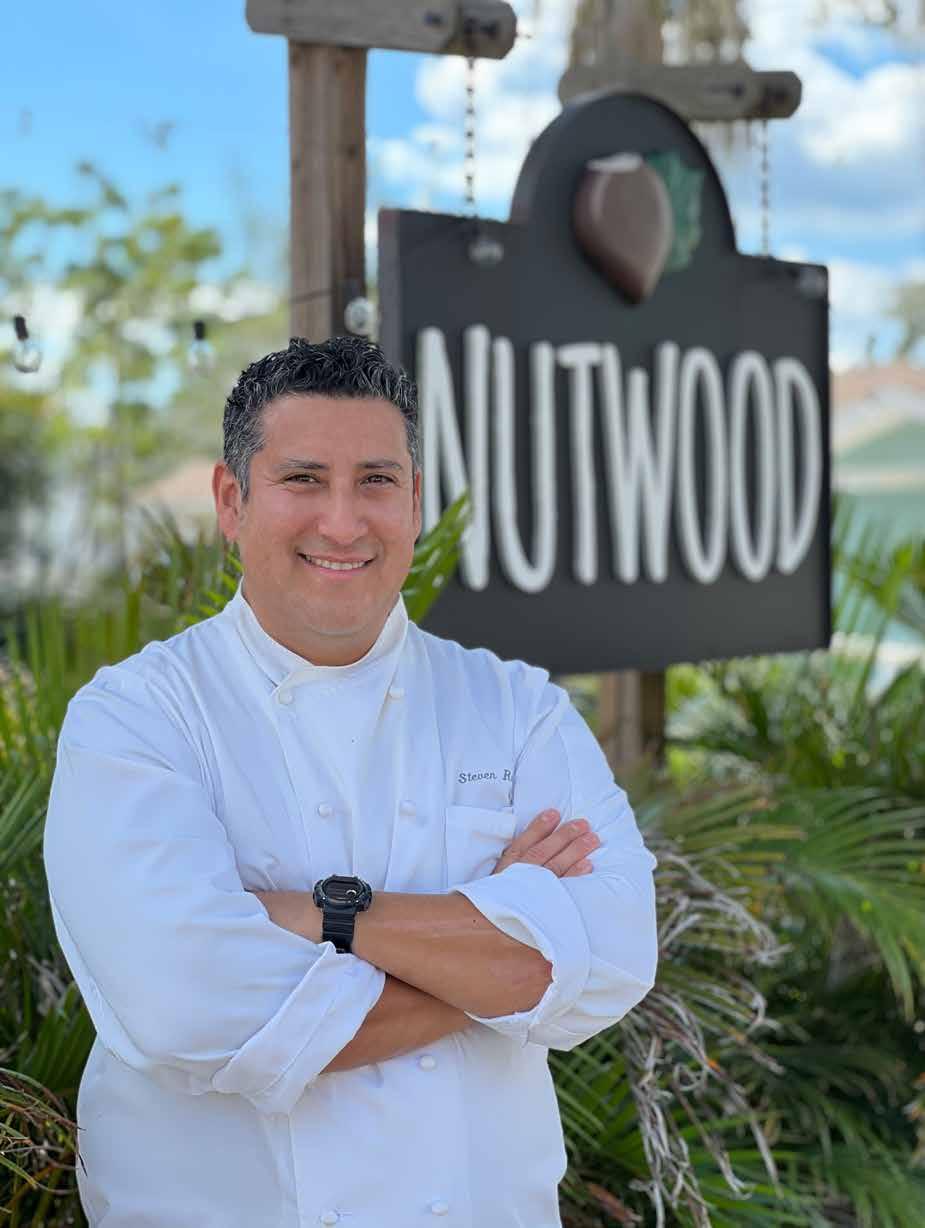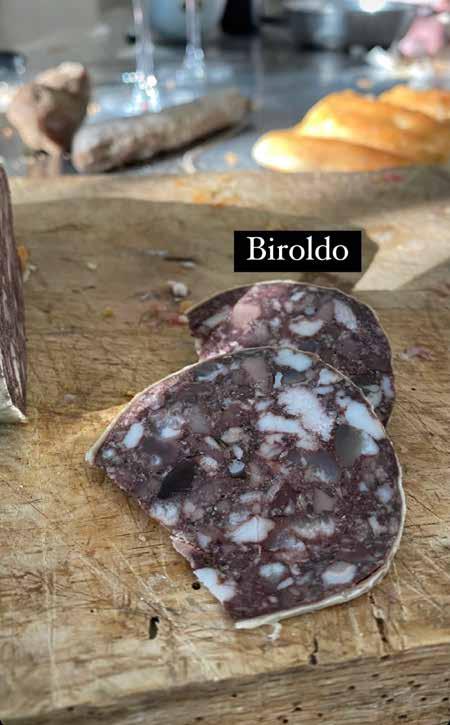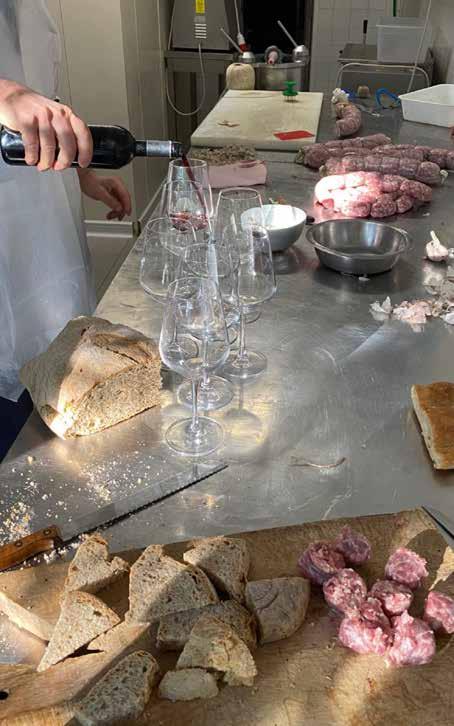
10 minute read
NUTWOOD
WORDS Tara Crutchfield PHOTOGRAPH Amy Sexson
Winter Haven’s premier farm-to-table restaurant, Nutwood, celebrated five years last month. Owner and Michelin Starred Chef, Steven Rojas, looks to Nutwood’s future, including a kitchen expansion, cosmetic renovations on the outdoor dining space, and a tasty new business that had him traveling to Europe to study tradition and craft. You might say Rojas’ new venture will ‘cure’ any savory cravings you have.
“It’s been a really hard five years,” reflected Rojas. The restaurant industry is demanding on a good day, but more so when dealing with a pandemic, staffing issues, and rising food costs. Run by an acclaimed chef and backed by a dedicated staff, Nutwood persists.
“People who want to work here don’t just want to make a dollar. It’s a career path for them. That’s the difference between us and other restaurants in general. To have the staff that we do, we’re very fortunate,” said Rojas. “I push the recipes, I push people to do better, and they want to do the same thing too.”
Nutwood vaunts farm-to-table cuisine in the truest sense of the term. Chef Rojas sources fresh produce from local farmers as often as possible, offers seasonal dishes, a curated wine selection, and even dry-ages his own beef for Nutwood’s menu. “Those little things that we do to set us apart, not because we want to be different, but because I think that’s the way people like to eat,” he said. “Farm to table is just what we do. We’re not doing it because it’s a hashtag or a cool, trendy thing to do. It’s something we do anyway.”
With items not typical for the area, like grilled Spanish octopus for dinner, Chef Rojas was “pleasantly surprised by how well our restaurant was received.” Some diners were hesitant at first, but according to the chef, “I stayed true to our convictions that this is what we were going to do and people would come.” And they did.
Today, Nutwood is a dining staple in the city with a customer base of foodies, loyal locals, and clientele who travel from around the state to meet there.
Stark white walls, restrained photographs and artwork, and Edison light fixtures suspended above the simple, locallymade wooden tables create an intimate and straightforward atmosphere. The brick-lined, oak-shaded outdoor patio is bordered with foliage and strung with lights. Nutwood’s uncomplicated motif is purposeful on the chef’s part. “I want the food to be the center. I want the service to be the center,” he said. “A very intimate, chef-driven, food-focused, winefocused menu and restaurant with service that perceivably seems casual, but it’s not.”
Nutwood hospitality artfully toes the tightrope between finedining service and casual atmosphere without a stumble. Servers manage to pay attention to detail without the stuffiness of a traditional fine dining establishment. From food and drink to service and atmosphere, Rojas prefers to underpromise and overdeliver.
Over the next two years, Rojas plans to expand the kitchen and smarten the patio with the additions of pergolas, awnings, and more greenery to give each table a more intimate, enclosed feel. “There’s a lot of empty space, and I think if we put little things like that between tables, it almost feels like their own little hidden restaurant,” he said.
A BACKGROUND ON CHEF STEVEN ROJAS
Chef Rojas has been in the culinary industry for over 25 years. Originally from Culver City, California, Rojas’ culinary origins hearken back to his childhood. “My dad used to do a lot of Argentine barbecue on Sundays. My mom used to cook – even though she says she’s not a good cook, she really is an excellent cook. Growing up around good food was part of my upbringing. We rarely went out to restaurants. We always cooked at home. That connection to food came very early on in my life.”
Following an injury playing semi-pro soccer, Rojas enrolled in culinary school. From age 19, he prioritized working at the most desirable independently owned restaurants with James Beard Award Winners and Michelin Star chefs.
Culinary diploma in hand, Rojas moved to Chicago where he worked at Tru. His career took him to Patina Restaurant in LA, where we worked with Eric Greenspan and Walter Manzke. Around this time, Rojas was handed a 1990-something Michelin Guide Book from Spain and encouraged to travel, try to get a stage (unpaid internship) at some of the restaurants in the book, and learn as much as he could.
During a trip to visit family in Spain, Rojas drove through San Sebastián, a city in Basque Country renowned for its culinary scene, especially pintxos, a small dish similar to tapas. “You walk through the old parts of San Sebastián, and you could spend three hours just walking and eating,” Rojas said. “That’s the food culture there, and I was enamored by it. It’s not just sitting down and eating and going home. It’s more talking, hanging out, drinking, and eating.”
On the way back home, he knocked on the doors of several restaurants seeking a stage with room and board. The last restaurant he tried belonged to acclaimed three Michelin Starred chef Martín Berasategui.
Berasategui was sitting down reading a newspaper when Rojas entered. “It was surreal because I had a couple of travel books. I had a Relais & Châteaux and a Michelin Guide, and the Relais & Châteaux book had his face on it,” Rojas said. A starstruck Rojas was invited to come back the following January.
In January, Rojas booked a one-way ticket back to Spain and found himself in line for a stage at Berasategui’s three-star Michelin-rated restaurant. “There was a line of cooks – Japanese, French, Spanish, South American – from all over the world,” he said. He worked 15 to 20-hour days, five days a week for a month, learning a “classic Spanish style of cooking.”
“I learned a lot. I learned work ethic, professionality, and how to cook at that level. That was a very important part of my culinary career,” Rojas said.
He returned to California and took an executive chef position at Saddle Peak Lodge, earning a Michelin Star at age 28. Rojas went on to work at Chez Papa Resto in San Francisco and as Chef de Cuisine at The Rancho Bernardo Inn in San Diego.
The Michelin Starred chef moved to San Francisco, where he met his wife, AJ. The couple moved to Miami, where Rojas gained invaluable experience opening two restaurants from the ground up. Working with James Beard Winner Michelle Bernstein and Michelin-awarded Michael Mina, Rojas helped open Seagrape at the Thompson Miami Beach. “That was huge in my development as not only a chef but as a business owner,” he said. “How to open a restaurant within a budget, how to do it properly, and how to do it efficiently and fast – that experience helped me open this restaurant.”
Chef Rojas opened Nutwood in Winter Haven in just a month and a half, drawing from his experience at Seagrape. He served his first dish on February 1, 2017.
“We’ve had some ups and downs in the past five years, and we’ve managed to stay above water – mainly because I wanted this place to be successful,” said Rojas. “If my heart wasn’t in it or my passion wasn’t as great, this would never work.”
In 2018 and 2020, Nutwood was awarded the Golden Spoon Award from Florida Trend magazine. With the Michelin Guide coming to Florida, Rojas has even more incentive to push his culinary boundaries.
SALUMI… COMING SOON
Chef Rojas has had a charcuterie/ salumi business in mind for some time. “In fact, before I became a chef, I wanted to be a butcher.” He decided against the monotony of butchery, opting instead to pursue cooking. “I think I would not feel challenged,” he said of being a butcher.
“Now that we’re established, I have a staff, and I have a kitchen that can maintain the standard while I’m not here completely. I can focus my time on expanding and really learning how to do salumi and how to do charcuterie the old school way,” Rojas said.


That last part, ‘the old school way,’ was especially important to Rojas. Many who deal in salumi are self-taught or learn it second hand. Rojas wanted training straight from the source.
“That’s why I wanted to go to Italy. That’s why I wanted to learn the traditional way of doing things because if your refrigeration doesn’t work or something happens, what do you do? You use your senses. These [Norcini] really are in tune with their senses as far as temperature, humidity, the feel of the meat.”
In January, Rojas traveled to Tuscany, Italy, to attend a course by Sapori & Saperi. Alongside two British chefs and two Slovakian chefs, he learned hands-on from Norcini and completed the Advanced Salumi Course. “As a chef, you can’t stop learning. You have to keep going. If not, you’re yesterday’s news,” he said.
According to material from the course, “Norcino means a person skilled in castrating a pig to fatten it, in slaughtering it and especially in working the meat to make salumi. It derives from Norcia, a town in the province of Perugia in Umbria, where in the past there were experts in all these skills. They traveled around the countryside, performing these tasks for farmers who didn’t have the necessary expertise. The traditional period for slaughtering the family pig is between Sant’Andrea (30 November) and Sant’Antonio (17 January).”
Throughout the course, Rojas learned the history and tradition of the Norcini. “Back in the day, if they were making bread in the morning, they would hang [the meat] in the area they were making bread so the meat wouldn’t get too humid. During the day, when it was too hot, they’d move it to the cellar. They were constantly moving the cured meat all over their restaurant, barn, or villa. They would throw buckets of water if it got too dry. Everything was by eye and by feel. They wouldn’t weigh things out. It’s a dying art form,” explained Rojas.
While in Italy, the chef, of course, had to sample the region’s delicious cuisine. When in Tuscany, right? He went to the hamlet of Colonnata, a village in the middle of Tuscany
- CONTINUED ON PAGE 34 -


known for lardo or cured pig fat, often draped over toast or whipped and spread over toast. “It’s like what bacon should taste like – this creamy, melt in your mouth animal fat that’s been salted and spiced,” the chef explained.
“That town overlooks the marble quarries in the mountain range there,” Rojas said. He drank wine and ate lardo on toast while watching the sunset over the marble quarry.
Chef Rojas is bringing the knowledge he gained in Italy back to Winter Haven for a charcuterie/ salumi business that will supply Nutwood and other projects and serve as a retail delicatessen, dry-aged beef program, and wine shop. The Nutwood proprietor is currently communicating with Heritage Breeders to source pigs for his business. “Assorted salumi, charcuterie products, and dry-aged meats all made in-house” could all be available in Winter Haven by the year’s end, “just in time for Christmas gift baskets.”
“It’s such a niche market that I think people will appreciate it,” said Nutwood owner and chef Steven Rojas. “But it takes a little time.”
Nutwood 132 Ave B SW, Winter Haven, FL (863) 229-7770 www.nutwoodwh.com FB @NUTWOODWH IG @nutwoodwh
A Michelin Star is the highest honor a chef can receive. “A Michelin Star is awarded for outstanding cooking. We take into account the quality of the ingredients, the harmony of flavours, the mastery of techniques, the personality of the chef as expressed in their cuisine and, just as importantly, consistency both over time and across the entire menu.” -guide.michelin.com.






